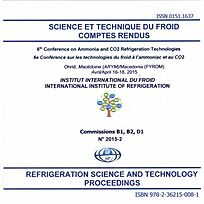
Document IIF
Internal reversible ammonia air-to-water heat pump/chiller.
Numéro : pap. n. 30
Auteurs : NIELSEN G., RASMUSSEN C.
Résumé
This paper will give an account of the background for and the stages in the development of an internally reversible ammonia air-to-water heat pump / chiller. (IRAW HP) The background for the development of the first version was a project where the specification demanded an ammonia chiller system that also could be used as a heat pump. There is neither river nor seawater available, boreholes where excluded partly due to fiscal considerations (investment cost app. €300 000), partly because the necessary ground area was not available. Therefore the heat dump / heat source had to be air. The solution suggested by the contractors included two chillers that would operate as a two stage system, but with a glycol circuit in between, and a dry cooler system as heat source. The overall system efficiency at design outdoor temperature of -8°C and a heat delivery temperature of 50°C was very low, as temperatures went up and down in the system configuration. The idea of moving the reversible action into the chiller unit was inspired by the defrost system of critically charged systems, developed by Star Refrigeration, but somewhat modified in the final design. Since this first system, the design has evolved, and further two systems have been supplied to the Bergen area in Norway and a fourth is under way, in yet a modified design.
Documents disponibles
Format PDF
Pages : 6 p.
Disponible
Prix public
20 €
Prix membre*
Gratuit
* meilleur tarif applicable selon le type d'adhésion (voir le détail des avantages des adhésions individuelles et collectives)
Détails
- Titre original : Internal reversible ammonia air-to-water heat pump/chiller.
- Identifiant de la fiche : 30014636
- Langues : Anglais
- Source : 6th Conference on Ammonia and CO2 Refrigeration Technology. Proceedings: Ohrid, North Macedonia, April 16-18, 2015.
- Date d'édition : 16/04/2015
Liens
Voir d'autres communications du même compte rendu (53)
Voir le compte rendu de la conférence
Indexation
-
Thèmes :
Techniques des pompes à chaleur;
Ammoniac;
Refroidisseurs d'eau - Mots-clés : Conception; Réversibilité; Refroidisseur; Ammoniac; Air-eau; Pompe à chaleur; Norvège
-
Unutrašnja reverzibilna amonijacna toplotna pum...
- Auteurs : NIELSEN G., RASMUSSEN C.
- Date : 12/2016
- Langues : Serbe
- Source : 47th International HVAC&R Congress and Exhibition.
- Formats : PDF
Voir la fiche
-
Extreme low charge units with ammonia blend R72...
- Auteurs : SVINGÁL J.
- Date : 27/04/2023
- Langues : Anglais
- Source : 10th IIR Conference on Ammonia and CO2 Refrigeration Technologies.
- Formats : PDF
Voir la fiche
-
Model-based feedback control of an ammonia-wate...
- Auteurs : GOYAL A., RATTNER A. S., GARIMELLA S.
- Date : 02/03/2014
- Langues : Anglais
- Source : International sorption heat pump conference (ISHPC2014), College Park, United States, March 31-April 2, 2014.
- Formats : PDF
Voir la fiche
-
NEWLY DEVELOPED HEAT PUMP-WATER CHILLERS WITH M...
- Auteurs : BINNEBERG A., ULBRICH G.
- Date : 03/09/1984
- Langues : Anglais
- Source : Advances in refrigeration and heat pump technology achieved by the application of micro-electronics and the control of systems by micro-electronic devices.
- Formats : PDF
Voir la fiche
-
Dynamic model for small-capacity ammonia-water ...
- Auteurs : VISWANATHAN V. K., RATTNER A. S., DETERMAN M. D., et al.
- Date : 16/07/2012
- Langues : Anglais
- Source : 2012 Purdue Conferences. 14th International Refrigeration and Air-Conditioning Conference at Purdue.
- Formats : PDF
Voir la fiche
